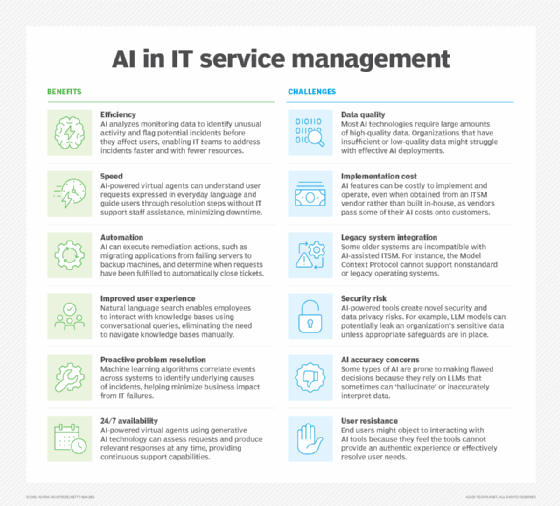
ITSM meets AI: Capabilities, challenges and what's next
AI promises to transform ITSM through automation and intelligence, but success depends on matching the right AI type to specific challenges while weighing benefits against costs.
AI has enormous potential to transform IT service management, but potential is the operative word.
The extent to which AI can actually enhance ITSM varies widely across organizations, depending on the specific types of AI adopted and the ITSM challenges being addressed.
This article examines the current role of AI in ITSM, identifies emerging trends shaping their intersection, and provides guidance for deciding whether AI-driven ITSM makes sense for your business.
What is ITSM?
ITSM is the strategic approach to designing, delivering, managing and improving IT services within an organization. It provides a structured framework for aligning IT services with business needs and delivering value to users.
ITSM encompasses a wide range of IT activities, including the following:
- Infrastructure management. Setting up and managing the back-end servers that host enterprise applications.
- Asset provisioning. Providing and configuring hardware, such as laptops, for employees.
- Technical support. Delivering end-user assistance when employees encounter issues -- e.g., login problems or printing difficulties.
The concept of ITSM dates back to the 1960s when IT resources first entered business environments. However, ITSM practices have evolved alongside technical advancements.
AI capabilities in ITSM
AI can enhance ITSM by automating processes, enhancing decision-making and improving service delivery across multiple operational areas.
Incident management
When troubleshooting an IT incident, such as an application failure or a crashed server, AI can assist in three key ways:
- Anomaly detection. AI analyzes monitoring data to identify unusual activity and flag potential incidents before they affect users.
- Automated response. AI can execute predefined remediation actions, such as migrating applications from failing servers to backup machines.
- Root cause analysis. Machine learning algorithms can correlate events across systems to identify underlying causes.
These capabilities enable IT teams to address incidents faster and with fewer resources, minimizing downtime and business impact.

Service requests
AI-powered virtual agents can help IT organizations handle service requests through multiple integrated capabilities. For example, virtual agents that excel at natural language processing can process user requests expressed in everyday language. In many cases, agents can enable self-service by guiding users through resolution steps without the assistance of IT support staff.
The technology behind virtual agents has evolved significantly. Current systems use generative AI to assess incoming requests and produce contextually relevant responses.
Security and compliance
AI tools can help ensure that ITSM processes remain secure and compliant.
For example, AI-driven analytics software can scan the configuration of a new laptop to verify appropriate permission settings. Moreover, AI tools can analyze network traffic in a cloud environment to detect potential indicators of an attack.
Ticket management
AI streamlines ticket handling in various ways, including the following:
- Identifying and consolidating duplicate tickets.
- Flagging incomplete tickets.
- Suggesting additional data on ticket submissions.
- Summarizing tickets to make them easier for IT teams to interpret.
In some cases, AI tools can determine when requests have been fulfilled and automatically close tickets.
IT knowledge management
In ITSM, knowledge management involves creating and using documentation about IT systems and processes. AI can help in this context in two main ways:
- Document generation. IT admins can create documentation using AI-powered text generators. AI tools might even generate documentation by analyzing system or workflow configurations.
- Natural language search. AI-powered search tools enable employees to interact with knowledge bases using conversational queries. This eliminates the need for manual navigation, which can be tedious and challenging.
Types of AI in ITSM
AI is a broad term that refers to a diverse range of technologies, each with distinct applications in ITSM. Understanding these different AI categories is essential for matching the right capabilities with specific service management challenges.
Analytical AI
Analytical AI systems excel at identifying patterns and detecting anomalies within an IT environment. As one of the more established AI applications in ITSM, these systems have become standard IT monitoring and incident management software components. Their primary strength is their predictive capability: They continuously analyze operational data to flag potential issues before they escalate into service disruptions.
Generative AI
GenAI can manufacture content, interact with end users and create documentation. It is a newer form of AI that has only become common within ITSM software over the past few years. It's now widely used to power chatbots and virtual end-user assistants.
Agentic AI
Agentic AI automates complex processes by combining AI models with execution capabilities to remediate IT failures and other sophisticated tasks. Although businesses have long used scripts to automate basic IT processes, which could be considered an early form of agentic AI, modern implementations draw on large language models (LLMs) to guide operations with greater intelligence and adaptability. This represents one of the newest and fastest-evolving facets of AI in ITSM, with many vendors still developing their capabilities.
Despite the importance of these distinctions, ITSM tool vendors don't always clearly distinguish between the types of AI capabilities in their offerings. Nonetheless, recognizing the difference remains crucial for evaluating technologies and understanding AI features' practical applications and limitations within their service management framework.
Challenges to AI adoption in ITSM
While AI can significantly enhance efficiency and speed across many ITSM workflows, organizations face several challenges when implementing these technologies.
Data quality constraints
AI technologies typically require vast amounts of high-quality data to function effectively. Organizations with insufficient data volumes or poor data quality might struggle to deploy AI-powered tools successfully within their ITSM frameworks. AI systems cannot deliver reliable or meaningful results without comprehensive data sets for training.
Financial considerations
Implementing and operating AI features often involves considerable expense. Even when businesses opt to acquire AI features through ITSM vendors rather than building them internally, costs remain high as vendors inevitably pass some of their AI development costs and operational expenses onto customers.
Legacy system integration issues
Many older systems are not compatible with AI-assisted ITSM approaches. For instance, the Model Context Protocol, a popular framework for building agentic AI tools, cannot support nonstandard or legacy OSes, creating a technology barrier for organizations with established infrastructure.
User acceptance hurdles
End users might object to interacting with AI tools for numerous reasons, including concerns that AI interactions feel impersonal and mechanical and lack the nuanced understanding that human support staff provide. Skepticism can undermine adoption efforts regardless of the technology's actual capabilities.
Accuracy and reliability concerns
Certain AI types, including generative and agentic AI, are prone to making flawed decisions. Their limitations are due primarily to their reliance on LLMs. The architectural design of LLM models sometimes produces "hallucinations" or misinterpretations of input data, potentially leading to incorrect actions or recommendations.
Security and privacy vulnerabilities
AI-powered tools introduce novel security and data privacy risks. For example, when a business uses an AI model to help generate or navigate IT documentation, and other companies use that same model, potential data leaks between organizations become possible without appropriate safeguards.
For many businesses, the value of AI-assisted ITSM capabilities outweighs these drawbacks. Still, understanding these limitations is essential for making informed implementation decisions. While AI offers powerful enhancements to ITSM processes, it's not ideal for every situation.
What's next for AI and ITSM? Trends and outlook
No one, not even the best AI models, can predict the future accurately. Still, it seems clear that a few key trends will define AI's role in ITSM over the next several years, particularly the following trends.
Agentic AI adoption
As noted above, agentic AI is, in many ways, the new frontier for AI. In the context of ITSM, agentic AI is a big deal because it opens the door to key ITSM use cases. For example, imagine an AI agent responding to a user's request who can't log into their computer. The agent automatically scans the systems, determines the issue and resolves it. At the same time, the agent remains in conversation with the user, creating, updating and eventually closing out an IT ticket to track progress on the request.
This is the advanced agentic AI use case that ITSM software might support in the future, although no ITSM systems can really pull it off today.
Bridging ITSM with ESM
ITSM focuses on managing IT processes and assets. Enterprise service management, or ESM, is a broader practice encompassing all business processes -- e.g., employee onboarding, HR ticket management and facilities management. Historically, ITSM and ESM were distinct because they required different tools and workflows. However, because AI can help automate enterprise processes and IT processes, more businesses will likely begin adopting AI-based systems to unify ITSM and ESM to some extent.
This also means that ITSM vendors might use AI to help extend their systems into ESM platforms, while ESM vendors do the same, intending to support IT processes.
Evaluating AI's value for ITSM
While businesses will probably continue to adopt AI capabilities for ITSM in the coming years, they'll likely also weigh AI's value against the hype.
Streamlining an IT process using AI always has some benefit, but sometimes it might be minimal. For instance, using AI-enhanced search to find information in a knowledge base saves an employee some time and provides a better employee experience. However, employees typically don't search knowledge bases all that often. On average, the time saved by a feature like this might amount to an hour or two per employee per year. A business evaluating the adoption of AI for a scenario like this will need to decide whether the time savings are worth the cost of the feature. Furthermore, the organization must determine if the benefit outweighs the risks, such as the potential for an AI tool to leak sensitive data when it has access to a company's internal knowledge base.
This isn't to say that AI is never worth the cost in ITSM, but it's a reminder that just because AI can do something doesn't mean it's the best way for a business to do it.
Chris Tozzi is a freelance writer, research adviser, and professor of IT and society who has previously worked as a journalist and Linux systems administrator.







